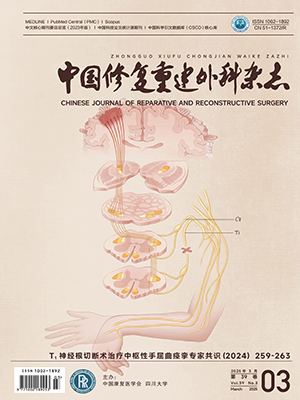| 1. |
Stans AA, Maritz NG, O'Driscoll SW, et al. Operative treatment of elbow contracture in patients twenty-one years of age or younger. J Bone Joint Surg (Am), 2002, 84-A(3):382-387.
|
| 2. |
Reichel LM, Milam GS, Reitman CA. Anterior approach for operative fixation of coronoid fractures in complex elbow instability. Tech Hand Up Extrem Surg, 2012, 16(2):98-104.
|
| 3. |
Adams JE, Sanchez-Sotelo J, Kallina CF, et al. Fractures of the coronoid:morphology based upon computer tomography scanning. J Shoulder Elbow Surg, 2012, 21(6):782-788.
|
| 4. |
Morrey BF, Chao EY. Functional evaluation of the elbow//Morrey BF.The elbow and its disorders. Philadelphia:WB Saunders, 1985:73-91.
|
| 5. |
徐群渊, 主译. 格氏解剖学. 39版. 北京:北京大学医学出版社, 2008:957-964.
|
| 6. |
Xiao-zhong Zhu, Xin Wang, Zhuo Ma. Comment on the anterior approach for coronoid process fracture. Eur J Orthop Surg Traumatol, 2014, 24(1):123-124.
|
| 7. |
孔祥玉. 局部解剖学. 西安:世界图书出版公司, 2014:152.
|
| 8. |
Doornberg JN, Ring D. Coronoid fracture patterns. J Hand Surg (Am), 2006, 31(1):45-52.
|
| 9. |
Clarke SE, Lee SY, Raphael JR. Coronoid fixation using suture anchors. Hand (N Y), 2009, 4(2):156-160.
|
| 10. |
Kälicke T, Muhr G, Frangen TM. Dislocation of the elbow with fractures of the coronoid process and radial head. Arch Orthop Trauma Surg, 2007, 127(10):925-931.
|
| 11. |
Aksu N, Korkmaz MF, Göğűş A, et al. Surgical treatment of elbow dislocations accompanied by coronoid fractures. Acta Orthop Traumatol Turc, 2008, 42(4):258-264.
|
| 12. |
Ring D, Doornberg JN. Fracture of the anteromedial facet of the coronoid process. Surgical technique. J Bone Joint Surg (Am), 2007, Suppl 2 Pt. 2:267-283.
|
| 13. |
Selesnick FH, Dolitsky B, Haskell SS. Fracture of the coronoid process requiring open reduction with internal fixation. A case report. J Bone Joint Surg (Am), 1984, 66(8):1304-1306.
|
| 14. |
Ameur NE, Rebouh M, Oberlin C. Anterior transbrachial approach of the coronoid apophysis. Chir Main, 1999, 18(3):220-225.
|
| 15. |
Shukla DR, Koehler SM, Guerra SM, et al. A novel approach for coronoid fractures. Tech Hand Up Extrem Surg, 2014, 18(4):189-193.
|
| 16. |
苏秀云, 唐佩福. 肘关节手术入路的解剖与临床. 中华解剖与临床 杂志, 2015, 20(3):276-280.
|
| 17. |
Han SH, Yoon HK, Rhee SY, et al. Anterior approach for fixation of isolated type III coronoid process fracture. Eur J Orthop Surg Traumatol, 2013, 23(4):395-405.
|
| 18. |
左玉明, 王志强, 王月光, 等. 尺骨冠突骨折的治疗. 中华骨科杂 志, 2006, 26(6):366-370.
|
| 19. |
Elkowitz SJ, Polatsch DB, Egol KA, et al. Capitellum fractures:a biomechanical evaluation of three fixation methods. J Orthop Trauma, 2002, 16(7):503-506.
|





 Baidu Scholar
Baidu Scholar